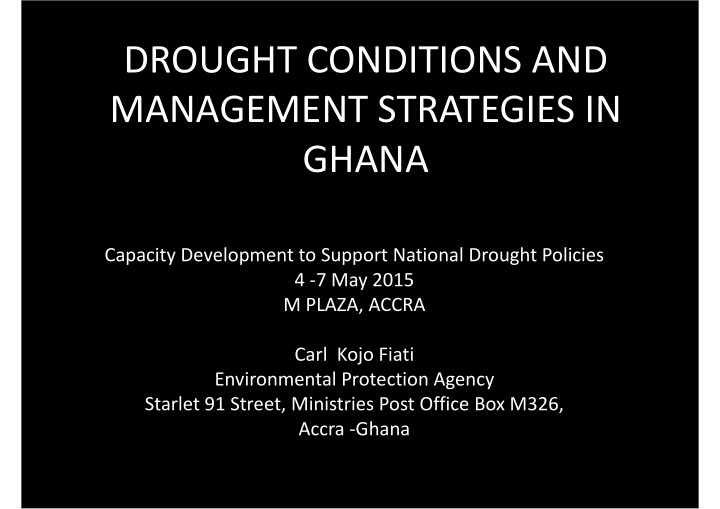



DROUGHT CONDITIONS AND MANAGEMENT STRATEGIES IN GHANA Capacity Development to Support National Drought Policies 4 ‐ 7 May 2015 M PLAZA, ACCRA Carl Kojo Fiati Environmental Protection Agency Starlet 91 Street, Ministries Post Office Box M326, Accra ‐ Ghana
Agro ‐ Ecological Zones Sudan Savannah Guinea Savannah Transitional Zone Deciduous Forest Coastal Savannah Rain Forest
Hydrological inter connectivity
Drought occrrence 1300 1200 1100 1000 North(Mean) 900 800 700 1983,1992, 2001 El Nino years 600 1965 1970 1975 1980 1985 1990 1995 2000 2005 2010 Rainfall variability here can be as high as 400mm between seasons
Frequency of annual rainfall being 80% or less of normal High Incidences of drought to the Western parts of northern High Incidences of Ghana drought around Kete ‐ Krachi (1961 ‐ 2007) High Incidences of High drought around Incidences of southern Central, drought Western and Volta around Regions, like , Nkwanta area. Ada,Kpetoe, Tsito, Cape Coast etc
Here high Incidences of drought covering most of the Western part of Ghana. (1961 ‐ 2007) Areas around Kete ‐ Krachi, Southern Volta, Central and Western Regions as well as Eastern Coasts are much affected (1961 ‐ 2007)
Monthly Maximum Value of Daily Max Temp for Wa
Monthly Minimum value of Daily Min Temp for Wa
Annual Count when Daily Minimum Temperature >20 degrees for Wa
Monitoring and Early Warning MONITORING INSTITUTIONS • Ghana Meteorological Authority • Ministry of Food and Agriculture • Hydrological Services Department • Water Resources Commission • Environmental Protection Agency • Research Institutions (Water Research Institute, Soil research Institute, and Universities)
Distribution of Synoptic Stations
Monitoring Institutions • Ghana Meteorological Authority • Ministry of Food and Agriculture • Hydrological Services Department • Water Resources Commission • Environmental Protection Agency • Research Institutions and Universities
Vulnerability Assessment Vulnerable sectors in order of severity • Energy • Agriculture and food production • Industry • Water supply • Fisheries
Most Vulnerable Groups • Women and Children • Small scale farmers without irrigation infrastructure • Unskilled industrial workers
Emergency relief and drought response • Key institution – National Disaster Management Organization (collaborating with other sectors through the Hydro ‐ meteorological disaster committee) • Other groups –(CSOs, WFP) • Measures are mainly in the form of food relief
Mitigation Measures • Building resilience in food production systems – Involving soil fertility improvement and soil water conservation measures focused on the Guinea and Sudan Savanna zones in the north – Formulation of a riparian buffer zone policy for protection of river and micro water sheds (2013) – Capacity development for development of community micro watershed plans in vulnerable communities
Training in Soil conservation methods Courtesy: EPA, Wa ‐ Ghana
Improving Soil Carbon through training in production and application of compost • Sample of prepared compost Courtesy : EPA, Wa ‐ Ghana
Need for Knowledge Skills on Drought Management • National Committee for Drought and Desertification inaugurated to facilitate actions to combat drought • Absence of an integrated national geospatial information infrastructure • Low level of skills for soil fertility and soil water conservation
I thank you for your attention
Recommend
More recommend